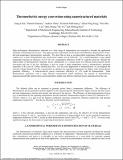Thermoelectric energy conversion using nanostructured materials
Author(s)
Chen, Gang; Kraemer, Daniel; Muto, Andrew Jerome; McEnaney, Kenneth; Feng, Hsien-Ping; Liu, Wei-Shu; Zhang, Qian; Yu, Bo; Ren, Zhifeng; ... Show more Show less
DownloadChen_thermoelectric energy.pdf (581.9Kb)
PUBLISHER_POLICY
Publisher Policy
Article is made available in accordance with the publisher's policy and may be subject to US copyright law. Please refer to the publisher's site for terms of use.
Terms of use
Metadata
Show full item recordAbstract
High performance thermoelectric materials in a wide range of temperatures are essential to broaden the application spectrum of thermoelectric devices. This paper presents experiments on the power and efficiency characteristics of lowand mid-temperature thermoelectric materials. We show that as long as an appreciable temperature difference can be created over a short thermoelectric leg, good power output can be achieved. For a mid-temperature n-type doped skutterudite material an efficiency of over 11% at a temperature difference of 600 °C could be achieved. Besides the improvement of thermoelectric materials, device optimization is a crucial factor for efficient heat-to-electric power conversion and one of the key challenges is how to create a large temperature across a thermoelectric generator especially in the case of a dilute incident heat flux. For the solar application of thermoelectrics we investigated the concept of large thermal heat flux concentration to optimize the operating temperature for highest solar thermoelectric generator efficiency. A solar-to-electric power conversion efficiency of ~5% could be demonstrated. Solar thermoelectric generators with a large thermal concentration which minimizes the amount of thermoelectric nanostrucutured bulk material shows great potential to enable cost-effective electrical power generation from the sun.
Date issued
2011-04Department
Massachusetts Institute of Technology. Department of Mechanical EngineeringJournal
Micro and Nanotechnology Sensors, Systems, and Applications III, 25-29 April 2011, Orlando, Florida, United States
Publisher
SPIE--the International Society for Optical Engineering
Citation
Chen, Gang et al. “Thermoelectric Energy Conversion Using Nanostructured Materials.” Proc. SPIE 8031, Micro and Nanotechnology Sensors, Systems, and Applications III, Ed. Thomas George, M. Saif Islam, & Achyut K. Dutta. 2011. 80311J–80311J–4. CrossRef. Web.
Version: Final published version
ISBN
0819486051
9780819486059
ISSN
0277-786X